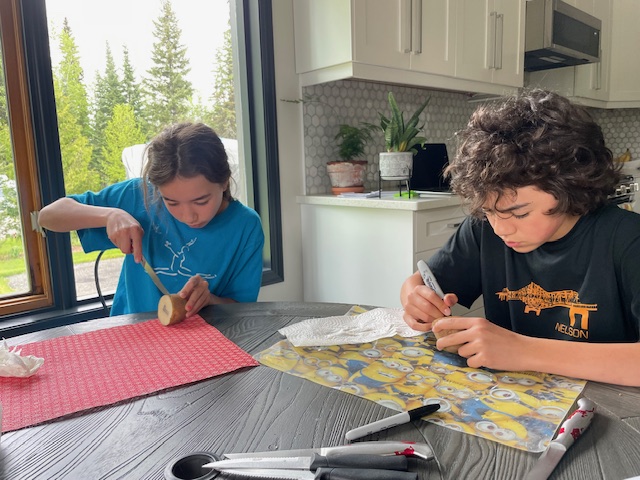Task 4: Manual Scripts and Potato Printing



I really enjoyed the potato printing process, especially because I got to share it with my kids. I had several 5 letter words in mind, but ultimately decided on “ocean” quite simply because I love the ocean. I grew up next to it and have always found its presence calming.
The most challenging part for me was carving out the mirrored reflection of the letter. I made that mistake a few times, but I found it became easier with practice. I also found curved letters harder to carve then the straight-line ones. During the stamping process, I struggled with aligning the stamps properly, especially in terms of spacing between letters. I found myself making several copies until it looked “right.” Given more time, I would have liked to play around with the style of my letters a bit more.
In terms of my letters, I noticed that those with straight edges turned out “better” (more defined). As I kept going, my letters got a bit bigger because they printed better that way and I started to play with shapes like adding the lowercase ‘a’. Overall, I liked that each print was a little different—it gave them character. There is an artistic charm to the imperfections at the edges and in the depths of color.
Considering the time this took (about 1 hour), I have a new appreciation for the time and technical skill required for type setting or writing text. When thinking about writing in its modern form, it’s easy to overlook its physicality. This brings me back to our initial module on the origins of the word “text”; as a creation requiring skilled craftsmanship or a physical art (Scholes, 1992). It’s hard to see that skillset as I’m typing out this post on my laptop.
When my kids asked why anyone would still make prints like in the Danny Cooke (2012) typesetting video, I explained that the slow and laborious process is now a lost art. Thanks to the podcasts this week (Lamb & McCormick, 2020), we talked about how, before typesetting, people wrote by hand on various materials, some of which were much more challenging to work with than pen and paper (vellum – not pleasant!). Considering the limited materials available in ancient times, the process would have been significantly more time-consuming, mistakes much harder to correct, and making multiple copies a luxury. I’m not sure if they totally “got it” but it certainly made me reflect on the artistry and effort inherent in the writing process.
So, how do I feel about the mechanization of writing? In some respects, it seems like mechanization has eroded some of the artistry and physicality of writing. However, it’s also granted us far greater accessibility. Overall, it makes me wonder if I value the act of writing less because of its mechanization. I think for me, the answer is yes. It’s something I rarely consider on the day to day, and because of that, I may not fully appreciate its significance. Activities like this can be quite humbling in that respect.


References:
Danny Cooke Freelance Filmmaker. (2012, January 26). Upside down, left to right: A letterpress filmLinks to an external site. [Video]. YouTube.
Lamb, R., & McCormick, J. (Hosts). (2020, May 26). From the vault: Invention of the book, part 1Links to an external site. [Audio podcast episode]. In Stuff to blow your mind. iHeart Radio.
Scholes, R. (1992). Canonicity and textuality.Links to an external site. In J. Gibaldi (Ed), Introduction to scholarship in modern languages and literatures (2nd ed., pp. 138-158). Modern Languages Association of America.